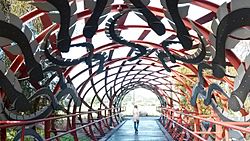Hinaki Eel Trap Bridge facts for kids
Quick facts for kids Hinaki (Eel Trap) Bridge |
|
|---|---|
 |
|
| Carries | Pedestrians and Cyclists |
| Crosses | Oakley Creek |
| Locale | War Memorial Park, Mount Roskill, New Zealand |
| Owner | Auckland Transport |
| History | |
| Engineering design by | Beca |
| Constructed by | Dempsey Wood |
| Opened | 5 June 2015 |
The Hinaki Bridge, also known as the Eel Trap Bridge, is a special footbridge in War Memorial Park, Mount Roskill, Auckland, New Zealand. It's about 20 metres long and lets people walk or cycle over Oakley Creek. This bridge is not just for crossing; its design tells an important story about Maori culture. It was built as part of a bigger project to improve the Dominion Road area, led by Auckland Transport.
The team that designed and built the bridge included Beca (who were the architects and engineers), Dempsey Wood (the builders), and Eastbridge (who made the steel parts).
The idea for the bridge came from Beca. They worked closely with six different iwi (Maori tribal) groups, the Puketapapa Local Board, and Auckland Council Parks. This teamwork made sure the bridge truly reflected local culture. Auckland Transport now owns the bridge.
Contents
How the Bridge Was Built
The journey to build the Hinaki Bridge started in May 2014. Beca was in charge of the whole project. They created the first ideas, designed everything in detail, got the necessary building permits, and oversaw the construction. Beca was responsible for the bridge's look, the surrounding landscape, and all the engineering work.
Many groups were involved in making decisions for the bridge. These included Ngati Whatua Orakei, Ngati Tamaoho, Te Akitai Waiohua, Ngati Maru, Ngai Tai ki Tamaki, Ngati Te Ata, the Puketapapa Local Board, Auckland Transport, and Auckland Parks. Everyone worked together to make sure the bridge was perfect.
The steel parts for the bridge were made by Eastbridge in Napier. This happened between October 2014 and February 2015. Then, Dempsey Wood started building the bridge in January 2015.
The Hinaki Bridge was officially opened on 5 June 2015. There was a special dawn blessing, which is a very important Maori ceremony. All the groups who helped create the bridge were there to celebrate.
Bridge Design and Structure
The Hinaki Bridge is made from strong steel and timber. It's designed to be stable and safe for everyone who uses it. The most interesting part of its design is how it looks like a hinaki. A hinaki is a traditional Maori eel trap.
The bridge has two sets of hoops: inner hoops and outer hoops. The outer hoops are only at the middle of the bridge and stop at the height of the handrail. This makes the middle part feel more open. At each end of the bridge, both the inner and outer hoops go all the way up. This creates a feeling of being enclosed, like inside a real eel trap.
The bridge also has cool steel eels swimming along its curving lines. These eels are made from light and dark grey steel plates and seem to be moving towards the centre of the bridge.
A Bridge with a Story
The design of the Hinaki Bridge is a tribute to the traditional double-headed Maori hīnaki, or eel trap. This bridge is more than just a way to cross the creek. It gives people a unique experience and helps share Maori culture with everyone in the community.
The bridge's design uses ideas from traditional Maori weaving patterns. These patterns were used to make the eel traps that were once common along Oakley Creek. The bridge takes these old ideas and brings them to life using modern steel.
The paths, special carved posts called pou, lighting, and signs (written in both Maori and English) all work with the bridge to tell the cultural story of Tuna Roa.
The Story of Tuna Roa
The main idea behind the bridge's design comes from an old Maori legend. This legend tells the story of Maui and Tuna Roa.

